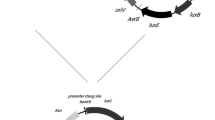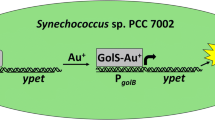Abstract
A whole-cell bacterial biosensor for measuring aqueous concentrations of aromatic aldehydes was developed. It is based on the E. coli BL21DE3(RIL) expressing the green fluorescent protein under the control of an alcohol dehydrogenase inducible promoter belonging to the archaeon Sulfolobus solfataricus (Sso2536adh promoter). Since it was previously reported that the BldR regulatory protein is the transcription factor required for aromatic aldehyde response in S. solfataricus, the gene encoding for the sensor protein BldR was co-expressed in the biosensor strain on a different compatible plasmid. Gel mobility shift assays showed that the purified recombinant protein can bind specifically to the Sso2536adh promoter. We demonstrated the ability of the archaeal promoter and the BldR transcription factor to operate in a bacterial context to drive active gene expression in a hybrid archaeal/eukaryal fusion. Furthermore, the E. coli BL21DE3(RIL) biosensor strain displayed a specific response and high sensitivity to the different aromatic aldehydes used, suggesting its potential low-cost application to environmentally relevant samples.







Similar content being viewed by others
References
Aucelli T, Contursi P, Girfoglio M, Rossi M, Cannio R (2006) A spreadable, non-integrative and high copy number shuttle vector for Sulfolobus solfataricus based on the genetic element pSSVx from Sulfolobus islandicus. Nucleic Acids Res 34:e114
Cannio R, Fiorentino G, Rossi M, Bartolucci S (1999) The alcohol dehydrogenase gene: distribution among Sulfolobales and regulation in Sulfolobus solfataricus. FEMS Microbiol Lett 170:31–39
Cha HJ, Srivastava R, Vakharia VN, Rao G, Bentley WE (1999) Green fluorescent protein as a noninvasive stress probe in resting Escherichia coli cells. Appl Environ Microbiol 65:409–414
Contursi P, Cannio R, Prato S, Fiorentino G, Rossi M, Bartolucci S (2003) Development of a genetic system for hyperthermophilic Archaea: expression of a moderate thermophilic bacterial alcohol dehydrogenase gene in Sulfolobus solfataricus. FEMS Microbiol Lett 218:115–120
Demir E, Kocaoğlu S, Kaya B (2008) Genotoxicity testing of four benzyl derivatives in the Drosophila wing spot test. Food Chem Toxicol 46:1034–1041
Fiorentino G, Cannio R, Rossi M, Bartolucci S (2003) Transcriptional regulation of the gene encoding an alcohol dehydrogenase in the archaeon Sulfolobus solfataricus involves multiple factors and control elements. J Bacteriol 185:3926–3934
Fiorentino G, Ronca R, Cannio R, Rossi M, Bartolucci S (2007) MarR-like transcriptional regulator involved in detoxification of aromatic compounds in Sulfolobus solfataricus. J Bacteriol 189:7351–7360
Geiduschek EP, Ouhammouch M (2005) Archaeal transcription and its regulators. Mol Microbiol 6:1397–1407
Grabowski B, Kelman Z (2003) Archaeal DNA replication: eukaryal proteins in a bacterial context. Annu Rev Microbiol 57:487–516
Heim R, Prasher DC, Tsien RY (1994) Wavelength mutations and posttranslational autoxidation of green fluorescent protein. Proc Natl Acad Sci USA 91:12501–12504
Heim R, Cubitt AB, Tsien RY (1995) Improved green fluorescence. Nature 373:663–664
Hirata A, Klein BJ, Murakami KS (2008) The X-ray crystal structure of RNA polymerase from Archaea. Nature 451:851–854
Kim MN, Park HH, Lim WK, Shin HJ (2005) Construction and comparison of Escherichia coli whole-cell biosensors capable of detecting aromatic compounds. J Microbiol Methods 60:235–245
Lei Y, Chen W, Mulchandani A (2006) Microbial biosensors. Anal Chim Acta 568:200–210
Liao VH, Chien MT, Tseng YY, Ou KL (2006) Assessment of heavy metal bioavailability in contaminated sediments and soils using green fluorescent protein-based bacterial biosensors. Environ Pollut 142:17–23
Limauro D, Pedone E, Pirone L, Bartolucci S (2006) Identification and characterization of 1-Cys peroxiredoxin from Sulfolobus solfataricus and its involvement in the response to oxidative stress. FEBS J 273:721–731
Miller WG, Brandl MT, Quinones B, Lindow SE (2001) Biological sensor for sucrose availability: relative sensitivities of various reporter genes. Appl Environ Microbiol 67:1308–1317
Pedone E, Bartolucci S, Fiorentino G (2004) Sensing and adapting to environmental stress: the archaeal tactic. Front Biosci 9:2909–2926
Prieto MA, Galán B, Torres B, Ferrández A, Fernández C, Miñambres B, García JL, Díaz E (2004) Aromatic metabolism versus carbon availability: the regulatory network that controls catabolism of less-preferred carbon sources in Escherichia coli. FEMS Microbiol Rev 28:503–518
Riccardi C, Di Filippo P, Pomata D, Incoronato F, Di Basilio M, Papini MP, Spicaglia S (2008) Characterization and distribution of petroleum hydrocarbons and heavy metals in groundwater from three Italian tank farms. Sci Total Environ 393:50–63
Schelert J, Drozda M, Dixit V, Dillman A, Blum P (2006) Regulation of mercury resistance in the crenarchaeote Sulfolobus solfataricus. J Bacteriol 188:7141–7150
Stiner L, Halverson LJ (2002) Development and characterization of a green fluorescent protein-based bacterial biosensor for bioavailable toluene and related compounds. Appl Environ Microbiol 68:1962–1971
Sudareva NN, Chubarova EV (2006) Time-dependent conversion of benzyl alcohol to benzaldehyde and benzoic acid in aqueous solutions. J Pharm Biomed Anal. 41:1380–1385
Tropel D, van der Meer JR (2004) Bacterial transcriptional regulators for degradation pathways of aromatic compounds. Microbiol Mol Biol Rev 68:474–500
van de Vossenberg JL, Driessen AJ, Konings WN (1998) The essence of being extremophilic: the role of the unique archaeal membrane lipids. Extremophiles 2:163–170
Verhees CH, Kengen SW, Tuininga JE, Schut GJ, Adams MW, De Vos WM, Van Der Oost J (2003) The unique features of glycolytic pathways in Archaea. Biochem J 375:231–246
Wang L, Arey J, Atkinson R (2005) Reactions of chlorine atoms with a series of aromatic hydrocarbons. Environ Sci Technol 39:5302–5310
Wheelis ML, Kandler O, Woese CR (1992) On the nature of global classification. Proc Natl Acad Sci USA 89:2930–2934
Wilkinson SP, Grove A (2006) Ligand-responsive transcriptional regulation by members of the MarR family of winged helix proteins. Curr Issues Mol Biol 8:51–62
Zhao B, Poh CL (2008) Insights into environmental bioremediation by microorganisms through functional genomics and proteomics. Proteomics 8:874–881
Acknowledgments
We are grateful to Patrizia Contursi for critically reading the manuscript and to Valentina Pisapia for her technical contribution. This work was supported by the Italian Ministry of Higher Education and Research (MIUR, PRIN 2004) and by the Regional Centre of Competence (CRdC ATIBB, Regione Campania, Naples, Italy).
Author information
Authors and Affiliations
Corresponding author
Rights and permissions
About this article
Cite this article
Fiorentino, G., Ronca, R. & Bartolucci, S. A novel E. coli biosensor for detecting aromatic aldehydes based on a responsive inducible archaeal promoter fused to the green fluorescent protein. Appl Microbiol Biotechnol 82, 67–77 (2009). https://doi.org/10.1007/s00253-008-1771-0
Received:
Revised:
Accepted:
Published:
Issue Date:
DOI: https://doi.org/10.1007/s00253-008-1771-0




